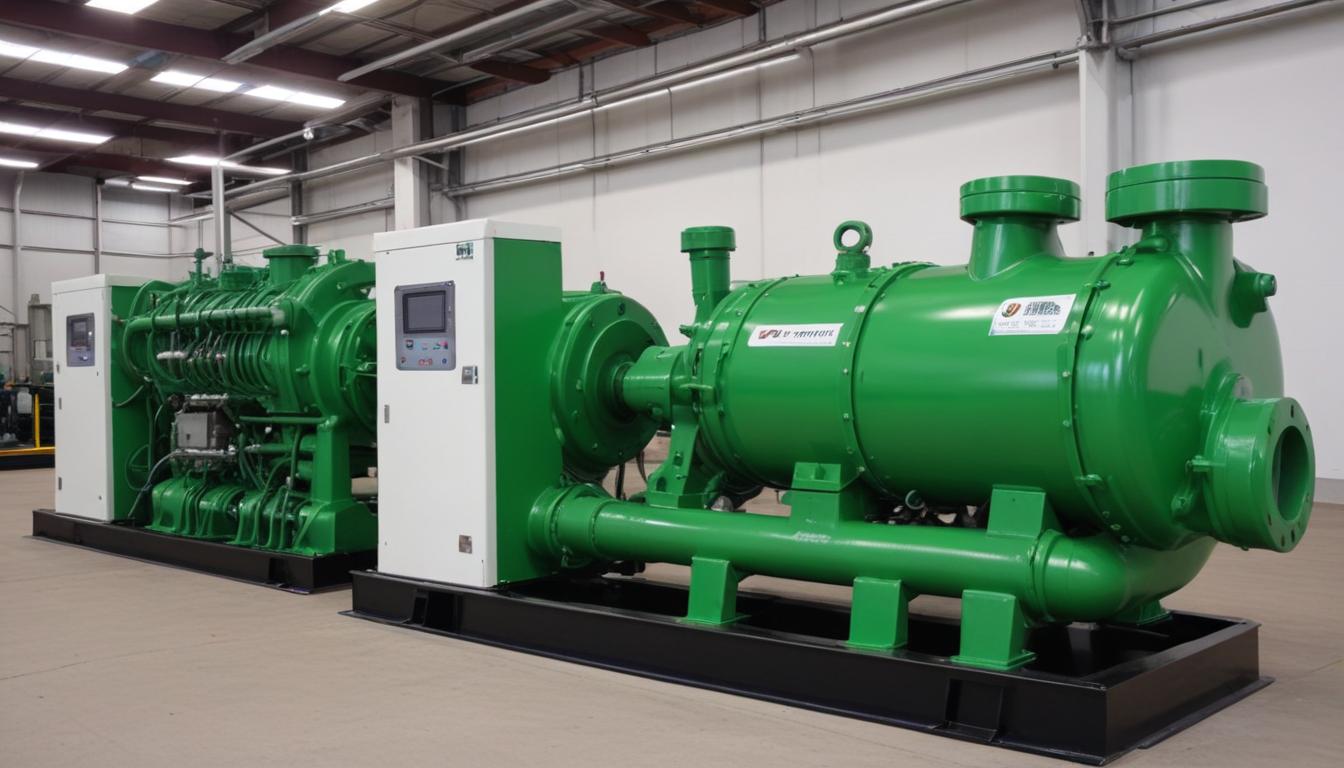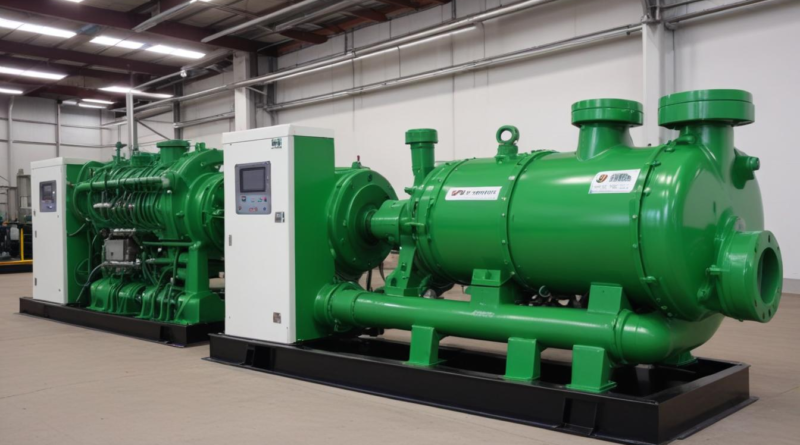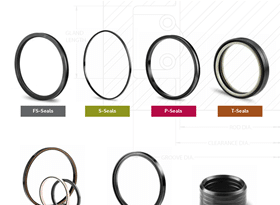green pump technologies
Green pump technologies represent a significant advancement in achieving sustainable operations across various sectors. These green pumps are designed to minimize energy consumption and reduce environmental impact, aligning with the global shift towards sustainable technology. By incorporating innovative features and efficient mechanisms, green pumps offer numerous benefits, including cost savings, enhanced performance, and lower carbon footprints.
One of the primary advantages of green pump technologies is their ability to significantly reduce energy usage. Traditional pumps can be energy-intensive, contributing to higher operational costs and increased greenhouse gas emissions. In contrast, green pumps utilize advanced designs and materials that enhance efficiency. Key features include:
- Variable Speed Drives (VSDs): Adjust the pump speed to match the required flow rate, ensuring optimal energy use.
- High-Efficiency Motors: Reduce electrical consumption while maintaining performance.
- Improved Sealing Systems: Minimize leakage and maintenance needs, extending the pump’s lifespan.
Additionally, green pump technologies often incorporate sustainable materials and environmentally friendly manufacturing processes. This commitment to sustainability not only reduces the ecological footprint but also ensures compliance with regulatory standards. A typical comparison between conventional and green pumps highlights the differences:
| Feature | Conventional Pumps | Green Pumps |
|---|---|---|
| Energy Efficiency | Lower efficiency, higher energy consumption | Higher efficiency, reduced energy usage |
| Materials | Standard metals and plastics | Sustainable and recyclable materials |
| Maintenance | Frequent maintenance required | Longer intervals between maintenance |
| Environmental Impact | Higher emissions and waste | Lower emissions and minimal waste |
The integration of green pump technologies extends beyond energy savings. These pumps contribute to broader environmental goals by reducing water usage and supporting efficient resource management. For organizations looking to enhance their sustainability initiatives, adopting green pumps can be a strategic move. The transition to these technologies not only supports ecological responsibility but also delivers economic advantages through decreased operational costs and improved system reliability.
In summary, green pump technologies offer a comprehensive solution for industries aiming to balance performance with environmental stewardship. By leveraging advanced designs, sustainable materials, and efficient operation, green pumps embody the principles of modern sustainable technology, delivering substantial benefits across various applications.
Energy-efficient pump designs
Advanced energy-efficient designs incorporate several innovative technologies that enhance the overall performance and sustainability of pump systems. One such technology is the integration of smart control systems, which utilize real-time data and machine learning algorithms to optimize pump operation based on varying demand and environmental conditions. These systems can predict maintenance needs, adjust operational parameters automatically, and ensure that pumps run only when necessary, thereby maximizing energy savings.
Another critical aspect is the hydraulic optimization of pump components. By refining the impeller design and minimizing hydraulic losses within the pump casing, engineers can significantly improve the efficiency of fluid movement. High-efficiency impellers are designed to reduce turbulence and cavitation, which not only enhances performance but also extends the lifespan of the pump by reducing wear and tear.
Thermal management also plays a vital role in energy-efficient pump designs. Efficient cooling systems and materials with high thermal conductivity help maintain optimal operating temperatures, reducing the energy required for cooling and preventing overheating. This thermal regulation ensures that motors and other electrical components operate within their most efficient temperature ranges, further contributing to energy savings.
To systematically evaluate and enhance the energy efficiency of pump systems, various certification programs and standards have been established. Standards such as the Pump Industry Initiative (Pii) and the Energy Star certification provide guidelines and benchmarks for manufacturers and users to assess the performance of pumps. Adhering to these standards not only ensures high efficiency but also promotes the adoption of best practices across the industry.
The benefits of these energy-efficient pump designs extend beyond mere energy savings. Organizations that implement these advanced systems experience reduced operational costs, lower carbon emissions, and improved reliability of their fluid handling processes. Additionally, the enhanced efficiency often translates to smaller pump sizes and reduced installation space, offering further economic and logistical advantages.
A comparison of traditional and advanced energy-efficient pump designs highlights the impact of these innovations:
| Aspect | Traditional Designs | Energy-Efficient Designs |
|---|---|---|
| Control Systems | Basic on/off controls | Smart, variable speed controls |
| Impeller Design | Standard impellers with higher turbulence | Optimized impellers with reduced cavitation |
| Thermal Management | Poor cooling leading to higher energy use | Efficient cooling systems maintaining optimal temperatures |
| Maintenance Requirements | Frequent maintenance due to wear and inefficiencies | Longer maintenance intervals with reliable performance |
Furthermore, the implementation of renewable energy integration in pump designs is gaining traction. Pumps powered by solar or wind energy not only reduce dependency on fossil fuels but also enhance the sustainability profile of operations. This integration is particularly beneficial in remote or off-grid locations where conventional energy sources are scarce or expensive.
Energy recovery systems are another innovative feature in modern pump designs. These systems capture and reuse energy from the pump’s operation, such as reclaiming heat or utilizing kinetic energy, thereby further reducing overall energy consumption. By recycling energy within the system, these pumps achieve higher efficiency and lower operational costs.
Incorporating these energy-efficient design principles ensures that green pumps meet the growing demand for sustainable technology while delivering significant benefits to users. The continuous advancements in pump technology promise even greater efficiency improvements and sustainability achievements in the years to come.
Sustainable materials and manufacturing
Sustainable materials and manufacturing processes are pivotal in the development and implementation of green pumps, ensuring that these technologies not only operate efficiently but also minimize their environmental footprint throughout their lifecycle. By prioritizing the use of eco-friendly materials and adopting responsible manufacturing practices, manufacturers can significantly enhance the sustainability profile of pump systems.
Sustainable Materials: The selection of materials plays a crucial role in the sustainability of green pumps. Key materials include:
- Recycled Metals: Utilizing recycled steel and aluminum reduces the need for virgin materials, lowering energy consumption and greenhouse gas emissions associated with metal production.
- Biodegradable Plastics: Advanced biodegradable polymers offer durability while minimizing environmental impact, especially in applications where pump components are exposed to harsh conditions.
- Corrosion-Resistant Alloys: These materials extend the lifespan of pumps, reducing the frequency of replacements and the associated resource consumption.
- Composite Materials: Combining different materials to achieve enhanced performance characteristics allows for lighter and more efficient pump designs.
Environmentally Friendly Manufacturing Processes: Sustainable manufacturing encompasses practices that reduce waste, conserve energy, and lower emissions. Key strategies include:
- Energy-Efficient Production: Implementing energy-saving technologies and optimizing manufacturing workflows to reduce the overall energy consumption during production.
- Waste Minimization: Adopting lean manufacturing principles to minimize material waste and promote the reuse and recycling of scraps and by-products.
- Water Conservation: Utilizing closed-loop water systems and recycling water used in manufacturing processes to decrease water usage and prevent pollution.
- Green Supply Chains: Partnering with suppliers who adhere to sustainable practices ensures that the entire production chain aligns with environmental goals.
Life Cycle Assessment (LCA): Conducting comprehensive LCAs enables manufacturers to evaluate the environmental impact of green pumps from cradle to grave. This assessment considers factors such as:
- Resource extraction and material processing
- Manufacturing and assembly
- Transportation and distribution
- Usage and maintenance
- End-of-life disposal or recycling
By identifying areas with significant environmental impacts, manufacturers can target improvements and ensure that green pumps offer maximum sustainability benefits.
Recycling and End-of-Life Management: Designing pumps for easy disassembly and recycling facilitates the recovery of materials at the end of their useful life. Strategies include:
- Modular Design: Creating components that can be easily separated and replaced reduces waste and extends the pump’s lifespan.
- Material Tagging: Implementing clear labeling of materials aids in the efficient sorting and recycling of components.
- Take-Back Programs: Offering programs where manufacturers take back used pumps for recycling or refurbishing supports a circular economy.
Benefits of Sustainable Materials and Manufacturing: Adopting sustainable materials and manufacturing processes yields numerous advantages, including:
- Reduced Environmental Impact: Lower emissions, reduced resource consumption, and minimized waste contribute to a healthier planet.
- Cost Savings: Efficient use of materials and energy can lead to significant cost reductions in production and operational phases.
- Enhanced Reputation: Companies committed to sustainability can strengthen their brand image and meet the growing demand for environmentally responsible products.
- Regulatory Compliance: Aligning with environmental regulations and standards ensures that products meet necessary legal requirements, avoiding potential fines and sanctions.
The following table illustrates the comparison between traditional and sustainable manufacturing practices in pump production:
| Aspect | Traditional Manufacturing | Sustainable Manufacturing |
|---|---|---|
| Material Usage | Reliance on virgin materials with higher environmental costs | Incorporation of recycled and biodegradable materials |
| Energy Consumption | Higher energy usage with less efficient processes | Optimized energy use through advanced technologies and practices |
| Waste Generation | Significant waste with limited recycling opportunities | Minimized waste through lean manufacturing and recycling initiatives |
| Water Usage | High water consumption with potential pollution | Reduced water use with closed-loop systems and recycling |
| End-of-Life Management | Limited options for recycling or repurposing | Designed for disassembly and material recovery |
By integrating sustainable materials and adopting environmentally responsible manufacturing practices, the production of green pumps not only supports global sustainability objectives but also offers tangible benefits to manufacturers and users alike. These advancements ensure that green pumps remain at the forefront of sustainable technology, providing efficient and reliable performance while safeguarding the environment.
Applications in various industries
 Green pump technologies are integral to enhancing efficiency and sustainability across a multitude of industries. Their application not only optimizes operational performance but also contributes significantly to environmental conservation. Key sectors benefiting from these technologies include:
Green pump technologies are integral to enhancing efficiency and sustainability across a multitude of industries. Their application not only optimizes operational performance but also contributes significantly to environmental conservation. Key sectors benefiting from these technologies include:
- Water and Wastewater Management: Green pumps are pivotal in municipal water supply systems and wastewater treatment plants. They ensure efficient water distribution, reduce energy consumption, and minimize leakage, thereby supporting sustainable water management practices.
- Agriculture: In irrigation systems, green pumps facilitate precise water delivery, reducing waste and promoting efficient use of water resources. This leads to higher crop yields and lower operational costs for farmers.
- HVAC Systems: Heating, ventilation, and air conditioning systems utilize green pumps to circulate fluids with minimal energy usage, enhancing the overall energy efficiency of buildings and reducing utility expenses.
- Oil and Gas: Within the oil and gas industry, green pumps are used for fluid transportation and processing. Their energy-efficient design helps lower the carbon footprint of extraction and refining processes.
- Manufacturing: Green pumps support various manufacturing processes by providing reliable and efficient fluid handling. This not only improves production efficiency but also reduces energy costs and environmental impact.
- Renewable Energy: In renewable energy systems such as geothermal and solar thermal plants, green pumps play a crucial role in maintaining system efficiency and reliability, thereby supporting the transition to cleaner energy sources.
- Food and Beverage: Processing and packaging operations in the food and beverage industry benefit from green pumps through enhanced sanitary conditions, reduced energy consumption, and improved production workflows.
- Healthcare: Hospitals and medical facilities use green pumps in various applications, including HVAC systems, medical gas delivery, and wastewater management, ensuring efficient and reliable operations with minimal environmental impact.
The adoption of green pump technologies across these industries yields numerous benefits, such as:
- Energy Savings: Significant reduction in energy consumption leads to lower operational costs and decreased reliance on non-renewable energy sources.
- Enhanced Efficiency: Improved pump designs ensure optimal performance, reducing downtime and maintenance requirements.
- Environmental Compliance: Utilizing sustainable technologies helps organizations meet regulatory standards and achieve their environmental goals.
- Operational Reliability: Green pumps offer consistent and reliable performance, critical for industries that depend on continuous fluid handling.
A comparative analysis of green pump applications across different industries highlights the versatility and adaptability of these technologies:
| Industry | Application | Key Benefits |
|---|---|---|
| Water and Wastewater Management | Water distribution, wastewater treatment | Energy efficiency, reduced leakage, sustainable water use |
| Agriculture | Irrigation systems, livestock water supply | Precise water delivery, lower operational costs |
| HVAC Systems | Fluid circulation, temperature regulation | Enhanced energy efficiency, reduced utility expenses |
| Oil and Gas | Fluid transportation, processing | Lower carbon footprint, improved process efficiency |
| Manufacturing | Fluid handling in production processes | Increased production efficiency, reduced energy costs |
| Renewable Energy | Geothermal and solar thermal systems | System efficiency, support for clean energy |
| Food and Beverage | Processing, packaging operations | Sanitary conditions, energy savings, improved workflows |
| Healthcare | Medical gas delivery, wastewater management | Reliable operations, minimal environmental impact |
Implementing green pump technologies allows organizations across these diverse sectors to achieve greater sustainability and operational excellence. By leveraging advanced designs and energy-efficient mechanisms, green pumps not only support environmental objectives but also drive economic benefits through reduced energy costs and enhanced system performance.
Future trends and innovations
Emerging advancements in green pump technologies are poised to revolutionize the industry, driving further enhancements in sustainability and efficiency. These future trends and innovations focus on integrating cutting-edge technologies, developing smarter systems, and embracing circular economy principles to maximize the benefits of green pumps.
Internet of Things (IoT) Integration: The incorporation of IoT devices into pump systems enables real-time monitoring and data collection. By leveraging sensors and connected devices, operators can gain granular insights into pump performance, energy consumption, and maintenance needs. This connectivity facilitates predictive maintenance, reducing downtime and extending the lifespan of pumps.
Artificial Intelligence and Machine Learning: AI and machine learning algorithms are being utilized to analyze the vast amounts of data generated by IoT-enabled pumps. These technologies can optimize pump operations by predicting demand patterns, adjusting flow rates dynamically, and identifying inefficiencies. The result is a highly responsive and adaptive pump system that continuously improves its performance.
Advanced Materials and Coatings: Research into new materials and protective coatings is leading to the development of more durable and efficient pump components. Materials with enhanced corrosion resistance and reduced friction coefficients contribute to lower energy losses and longer maintenance intervals. Additionally, lightweight composite materials are being explored to reduce the overall weight of pump assemblies, further improving energy efficiency.
Energy Harvesting Technologies: Future green pumps may incorporate energy harvesting technologies that capture and reuse energy from the environment or the pump’s own operation. Examples include harnessing kinetic energy from fluid movement or utilizing thermal energy from temperature gradients. These innovations can contribute to the pump’s energy self-sufficiency, minimizing external energy dependencies.
Modular and Scalable Designs: The trend towards modular pump designs allows for greater flexibility and scalability in various applications. Modular systems can be easily expanded or reconfigured to meet changing operational requirements, reducing the need for complete system overhauls. This approach not only enhances sustainability by minimizing material waste but also lowers costs associated with upgrades and expansions.
Integration with Renewable Energy Sources: As the adoption of renewable energy sources grows, green pumps are being designed to operate seamlessly with solar, wind, and other renewable power systems. This integration ensures that pump operations remain sustainable even in off-grid or remote locations, supporting the broader transition to clean energy.
Enhanced Water Efficiency: Innovations aimed at improving water efficiency are becoming a key focus area. Advanced control systems and precise flow regulation mechanisms ensure that water usage is optimized, reducing waste and supporting sustainable water management practices. These advancements are particularly beneficial in sectors such as agriculture and municipal water supply.
Circular Economy Practices: Embracing circular economy principles, future green pump technologies emphasize the reuse and recycling of materials throughout the pump’s lifecycle. This includes designing for easy disassembly, promoting the use of recyclable materials, and establishing take-back programs for end-of-life pumps. These practices contribute to resource conservation and minimize the environmental impact of pump production and disposal.
The following table outlines some of the key future trends and their anticipated impacts on green pump technologies:
| Trend | Impact | Benefits |
|---|---|---|
| IoT Integration | Real-time monitoring and data analytics | Improved performance, predictive maintenance |
| AI and Machine Learning | Optimized operations and adaptive control | Enhanced efficiency, reduced energy consumption |
| Advanced Materials | Increased durability and reduced friction | Lower maintenance, longer lifespan |
| Energy Harvesting | Self-sustaining energy sources | Reduced external energy dependency |
| Modular Designs | Flexibility and scalability in applications | Cost-effective upgrades, minimal waste |
| Renewable Energy Integration | Seamless operation with renewable sources | Enhanced sustainability, support for clean energy |
| Water Efficiency | Optimized water usage and reduced waste | Support for sustainable water management |
| Circular Economy Practices | Reuse and recycling throughout lifecycle | Resource conservation, minimized environmental impact |
Smart Grid Compatibility: Future green pumps will be increasingly compatible with smart grid technologies, enabling better synchronization with energy supply and demand fluctuations. This compatibility allows for the balancing of load requirements and the efficient use of renewable energy sources, contributing to a more resilient and sustainable energy infrastructure.
Enhanced User Interfaces and Control Platforms: The development of more intuitive and user-friendly interfaces will empower operators to manage pump systems more effectively. Advanced dashboards and control platforms will provide comprehensive visibility into system performance, facilitating informed decision-making and swift adjustments to operational parameters.
Biomimetic Designs: Inspired by natural processes, biomimetic designs are being explored to create pump systems that emulate the efficiency and adaptability of biological organisms. These designs can lead to pumps that operate with lower energy inputs and are better suited to varying environmental conditions.
Adopting these future trends and innovations will ensure that green pump technologies continue to evolve, offering enhanced benefits in terms of efficiency, sustainability, and adaptability. As industries strive to meet increasingly stringent environmental standards and strive for operational excellence, these advancements will play a crucial role in shaping the next generation of sustainable pump solutions.



